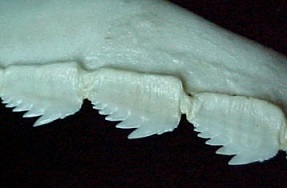New project may give insights into the evolution of human teeth
Press Release
Natural Environment Research Council
20. September 2013
—————————
NERC has agreed to fund a project worth nearly £680k to investigate how teeth evolved in our earliest ancestors.
 The three-year project could give researchers a new insight into the evolution and development of teeth and their arrangement in the mouth – called dentition. It may also reveal why humans and mammals only develop one or two sets of teeth in their lifetime, compared to their ancestors, the bony fish, which constantly regenerate their teeth.
The three-year project could give researchers a new insight into the evolution and development of teeth and their arrangement in the mouth – called dentition. It may also reveal why humans and mammals only develop one or two sets of teeth in their lifetime, compared to their ancestors, the bony fish, which constantly regenerate their teeth.
Every jawed vertebrate needs teeth to function and feed. But exactly how teeth evolved is poorly understood, because it is difficult to interpret different stages of tooth development from fossils.
“We still don’t have a clear understanding of how dentitions are built,” explained Professor Moya Meredith Smith of King’s College London, a principal researcher of the study. “To understand dentition patterns you need to look at animals that build their teeth on a regular basis, like fish.”
The team, co-ordinated by Dr Zerina Johanson of the Natural History Museum, plan to look at the development of different teeth arrangements in modern day vertebrates and then apply their findings to fossils from the same group.
Jawed vertebrates evolved into several different types of animal and fish, but there are only two major groups, which are still living today. One is sharks, or Chondrichthyes; while the other is Osteichthyes, or bony fish.
“Bony fish eventually evolved into mammals, like humans. But to define how the teeth evolved we don’t want to look at dentitions in mammals like mice. Instead, if you want to define how dentition evolved you need to look at more primitive members of groups,” explained Dr Zerina Johanson.
The grant will look at modern day Chondrichthyans, such as sharks and rays, to give them an insight into how the teeth from both these groups evolved.
While a lot is known about the dentition of modern day Osteichthyans, like tuna, salmon or seahorses, little is known about their early ancestors.
Professor Smith, Dr Johanson and their colleagues hope to change this when they compare their findings about Chondrichthyans to fossil specimens of early Osteichthyans. They hope to discover whether the two groups share a common dentition or whether the teeth in the cartilaginous sharks and rays evolved very differently to the boned fish.
The third principle investigator on the grant is Dr Gareth Fraser of the University of Sheffield. He will look at the genetics behind different types of dentition.
He said, “Osteichthyan dentitions have been intensely studied in recent years, and we even understand what genes are involved in producing these dentitions. Despite this, even within this group we know nothing about tooth development of more primitive Osteichthyans, such as the paddlefish and gar. As well, and perhaps somewhat surprisingly, we know very little about how genes control development of shark and ray dentitions.”
Dr Fraser also explained that, while teeth are not easily regenerated in the lab, the team are looking closely at natural tooth regeneration in fishes to see how they regenerate teeth and how it can be maintained in something like a shark, where there is continuous replacement.
“You can’t regenerate teeth but people are now starting to look more seriously at how certain fish regenerate teeth and some bony fish continually regenerate (although sharks do it more regularly),” said Dr Johanson. “If we can understand what cells and genes are involved in regeneration of shark teeth then maybe we can look at teeth in humans and see comparable genes that can be used to regenerate teeth. But that is still very much in the distant future.”
Source: NERC
